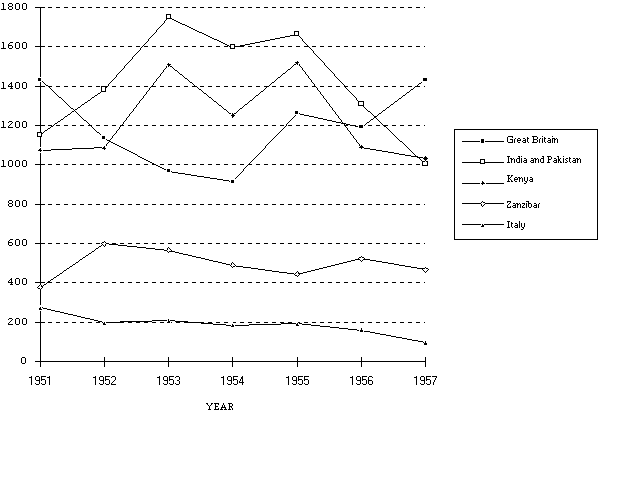
3.3- From the end of the Second World War
to the declaration of independence
All our fellow-countrymen who had been interned, were repatriated to Italy at the end of the War. However, some had acclimatised themselves and preferred living in the territory of Tanganyika so they decided to come back (24). They were certain that they would have greater possibilities and prospects than what Italy could offer them. The Italians were employed as craftsmen, or technical and civil work (mechanics and construction) of which the country had particular need. Some of them had already performed the same kind of duties during the period of internment. After 1947 the property of foreigners including some Italians, which had been confiscated and administered by the "Custodian of the Enemy Properties", was returned to the original owners.
The Fifties witnessed the arrival of other Italians who settled in different areas of Tanganyika. Some of them were employed on farms (cultivation of sisal in Morogoro, of tobacco in Iringa, of coffee and of pyrethrum in Arusha and Moshi). Others instead were attracted by the profitable opportunities offered by the mines, above all of gold (Gold Mining Co. of Geita, Tangold Co. of Musoma) and diamonds (Williamson Diamonds Ltd. of Mwadui), in the Region of Shinyanga. In the same period a noteworthy activity was carried out by the company M. Gonella (based in Nairobi) which implemented two important projects: the construction of some oil depots at Kurasini (Dar es Salaam) and the first sewerage scheme of Dar es Salaam. In those years some Italian contractors started their construction activities in Dar Salaam (25).
The census that took place in 1952 counted 17,885 European residents on the territory of Tanganyika of which 69.3% were British (12,395). The Italians were 1,071 and constituted the third largest community, after the Greeks (1,292), followed by the Dutch (515) the Germans (499), the Swiss (496) and the Americans (331) (Moffett, 1958, page. 303).
Even if the arrival of Italians in Tanganyika in the fifties (around 200 per year) seems insignificant, the examination of Chart 3.1. shows clearly that Italy constituted one of the main countries of origin of the immigrants in those years. It is possible to note, furthermore, the large immigration from India and from Pakistan which would lead to the formation of a very important minority active in the economy and the commerce of the country. Remarkable also is the number of arrivals from nearby Kenya (British citizens) and from Great Britain, charged with the continuing administration of the territory of Tanganyika after the Second World War by the United Nations.
Graph 3.1 - New arrivals in Tanzania according to the Country of origin (1951-1957)

Source: Tanganyika under the United Kingdom administration (1956 and 1958)
Stirling-Astaldi, an Italian-British company was the main Italian firm at the beginning of the Fifties. The company's first important contract was the construction of the Namanga-Arusha-Taveta road, followed by the stretch linking Dar es Salaam to Morogoro (26).
In the mid-fifties, through the initiative of the Italian resident community, the Italian Club was built and inaugurated in 1956 (27). At the end of the fifties the company Italwood was established. It introduced the first parquet flooring (28) onto the local market. In those years direct connections with Italy were provided by the Italian shipping company Lloyd Triestino, which berthed in the harbour of Dar es Salaam through regular passenger and freight services (29).